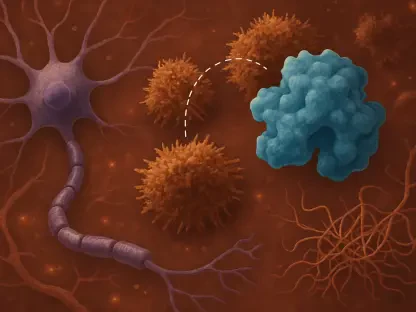Imagine a world where millions of people struggle with high cholesterol, a silent threat that fuels heart disease, yet many cannot tolerate standard treatments like statins due to side effects or poor response, leaving them at risk. This pressing challenge affects countless lives, with cardiovascular disease remaining a leading cause of death globally. To explore groundbreaking solutions, this roundup gathers diverse opinions, expert tips, and critical reviews from multiple sources in the medical and technological fields. The focus is on how artificial intelligence (AI) has recently emerged as a tool to identify new lipid-lowering effects in already approved drugs, potentially transforming cardiovascular care. By synthesizing varied perspectives, this discussion aims to shed light on the promise and pitfalls of this innovative approach.
Exploring the Impact of AI on Cardiovascular Treatment
The Urgent Need for New Lipid-Lowering Options
Hyperlipidemia, characterized by elevated blood lipid levels, poses a significant risk for heart conditions, yet current therapies often fall short. Many patients experience muscle pain or other adverse effects from statins, leaving a gap in effective management. Insights from cardiovascular specialists highlight that nearly a third of patients on standard treatments fail to reach target lipid levels, underscoring an urgent need for alternatives. This gap has driven researchers to seek novel solutions beyond traditional drug development.
A growing consensus among healthcare professionals points to drug repurposing as a viable strategy. Instead of creating new compounds from scratch—a process that can take over a decade—repurposing existing medications offers a faster route to treatment. The integration of AI into this process has sparked excitement, as it promises to analyze vast datasets of approved drugs to uncover hidden therapeutic potential, specifically for lowering lipids.
AI as a Game-Changer in Drug Repurposing
Technology experts in the healthcare sector emphasize that AI’s ability to process massive amounts of data is revolutionizing drug discovery. Machine learning models can sift through thousands of FDA-approved drugs to predict which might exhibit lipid-lowering effects, a task that would be impractical through manual analysis. Reports suggest that such models have already identified dozens of candidates, narrowing down a pool of over 3,000 compounds to a select few with promising profiles.
However, not all opinions are uniformly optimistic. Some data scientists caution that while AI excels at pattern recognition, its predictions can sometimes lack biological context. This has led to calls for balancing computational insights with real-world evidence, ensuring that enthusiasm for technology does not outpace scientific rigor. The dialogue around AI’s role often centers on its potential to accelerate timelines while acknowledging the complexity of human physiology.
Diverse Perspectives on AI-Driven Discoveries
Validation Challenges and Clinical Relevance
Pharmacologists and clinical researchers stress the importance of validating AI findings through robust testing. Retrospective clinical data, animal studies, and molecular analyses are frequently cited as essential steps to confirm whether a drug flagged by AI can truly lower lipid levels in patients. One viewpoint holds that without such multi-layered validation, there is a risk of false positives, which could waste resources or even harm patients if rushed to application.
In contrast, some technology advocates argue that the speed of AI-driven predictions justifies a more streamlined validation process. They suggest that initial clinical trials could be fast-tracked for the most promising candidates, given the urgent need for new treatments. This divergence in opinion reveals a tension between caution and innovation, with both sides agreeing on the ultimate goal of patient safety but differing on the pace of implementation.
A third perspective comes from regulatory experts who highlight the hurdles of gaining approval for repurposed drugs. Even with solid evidence, navigating the regulatory landscape can be daunting, as agencies often require extensive documentation of new therapeutic uses. This complexity suggests that while AI may hasten discovery, the path to market remains fraught with challenges that demand careful consideration.
Personalized Medicine and Global Implications
Insights from geneticists and personalized medicine specialists reveal a strong interest in tailoring lipid-lowering treatments to individual patient needs. AI’s ability to identify diverse drug candidates offers hope for those who do not respond to conventional therapies, potentially matching treatments to specific genetic or metabolic profiles. This approach is seen as a step toward more equitable care, addressing variations in patient responses that have long been overlooked.
On a global scale, public health officials note that hyperlipidemia treatment needs differ widely across regions due to disparities in healthcare access and disease prevalence. AI-driven solutions are viewed as adaptable, with the potential to prioritize drugs that are already widely available in lower-resource settings. However, skepticism persists about whether such technologies will be equitably implemented, with concerns that high costs or technical barriers could limit benefits to wealthier nations.
An additional angle comes from patient advocacy groups, who emphasize the human impact of these innovations. For individuals struggling with statin intolerance, the prospect of alternative medications is a beacon of hope, yet there is a call for transparency about risks and timelines. This viewpoint underscores the need to keep patient experiences at the forefront of technological advancements in medicine.
Practical Applications and Expert Tips for Healthcare Providers
Integrating AI Findings into Clinical Practice
Healthcare consultants advise clinicians to stay informed about AI-identified drug candidates, particularly as clinical trials progress over the coming years. One practical tip is to identify patients with unmet needs—such as those with statin intolerance—and consider enrolling them in studies testing repurposed drugs. This proactive approach could help gather real-world data while offering potential relief to those in need.
Another suggestion from medical educators focuses on interdisciplinary collaboration. Physicians are encouraged to partner with data scientists and pharmacologists to better understand AI tools and their outputs. By fostering such partnerships, healthcare providers can critically assess computational predictions and contribute to refining these technologies for clinical relevance.
Policy analysts also weigh in, recommending that hospitals and research institutions advocate for funding to support validation studies. Securing resources for experimental and clinical testing is seen as critical to bridging the gap between AI predictions and bedside application. This collective input highlights a shared recognition of AI’s potential, paired with actionable steps to ensure its responsible use.
Navigating the Future of Drug Development
Industry leaders in pharmaceutical innovation suggest that AI could redefine the economics of drug development by slashing costs and timelines associated with bringing new treatments to market. Unlike traditional methods, repurposing leverages existing safety data, which can expedite regulatory reviews. This perspective is often contrasted with warnings about scalability, as not all drugs flagged by AI may prove feasible for widespread use.
Regulatory advisors offer a complementary tip, urging stakeholders to engage early with approval bodies to clarify requirements for repurposed drugs. Such dialogue can preempt delays and ensure that promising candidates are not stalled by bureaucratic obstacles. This advice reflects a broader call for systemic adaptation to accommodate tech-driven paradigms in medicine.
Academic researchers add a forward-looking note, proposing that lessons from lipid-lowering drug repurposing could inform efforts in other therapeutic areas. Fields like oncology or neurology might benefit from similar AI approaches, expanding the impact of this technology. This cross-disciplinary vision encourages a mindset of exploration while maintaining a focus on rigorous validation.
Reflecting on a Milestone in Medical Innovation
Looking back, the exploration of AI’s role in identifying lipid-lowering effects in approved drugs marked a significant moment in cardiovascular research. The diverse opinions and expert insights gathered revealed a shared optimism tempered by calls for caution, reflecting a field in the midst of transformation. As discussions unfolded, the balance between technological promise and scientific validation emerged as a central theme, shaping how innovations were perceived and implemented.
Moving forward, stakeholders were encouraged to prioritize collaborative efforts, bringing together clinicians, technologists, and regulators to refine AI applications in healthcare. A key next step involved investing in large-scale clinical trials to test the most promising drug candidates, ensuring that patient safety remained paramount. Additionally, advocating for policies that support equitable access to these emerging treatments was seen as vital to maximizing their global impact. This collective journey toward integrating AI into medicine offered a blueprint for addressing other pressing health challenges with creativity and rigor.









